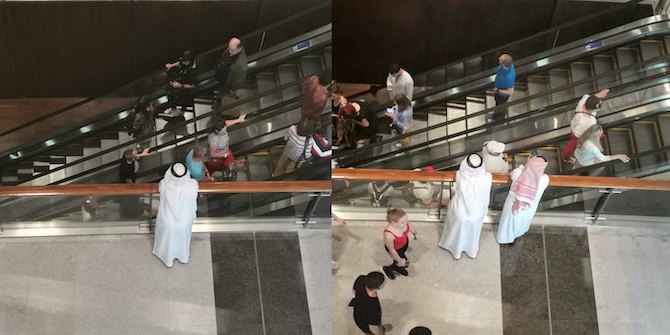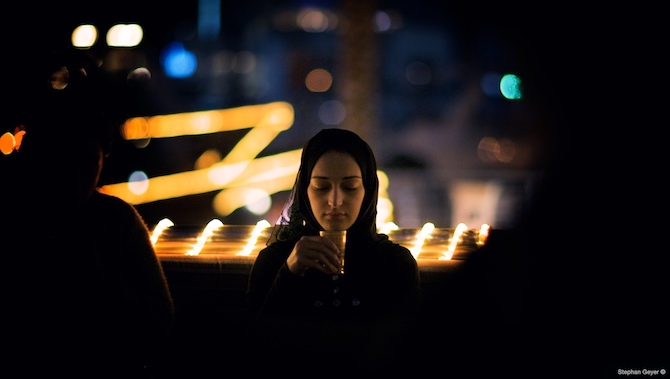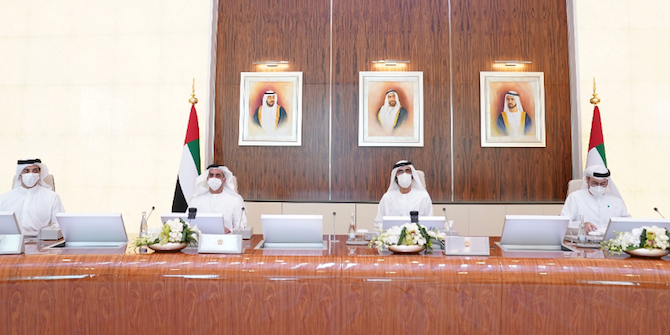by Rana AlMutawa

When I wrote the blog post Challenging Concepts of Authenticity: Dubai and Urban Spaces in the Gulf two years ago, I was still in the midst of conducting my fieldwork. Since then, I have expanded upon this topic in several articles. In the most recent, I explored how Dubai’s inhabitants experience belonging in ‘glitzy’ spaces such as shopping malls and new developments and the social contestations that happen there. I argued that places like shopping malls are important cultural sites where social norms are constantly being negotiated, observed and challenged. However, I also studied the exclusions that take place in these ‘glitzy’ settings, demonstrating that belonging is often built on exclusions based on the intersections of race, class and a variety of other factors. In this blog post, I will explore the complexity of navigating belonging and exclusion throughout my fieldwork.
Rather than discussing my ethnographic findings and analysis, which I detail in my other published work, I would like to give space to the questions and conversations I had throughout the research process. In a way, I find that these nagging questions are some of the most important aspects of academic inquiry.
To do this, I’ll backtrack a few years, even before I wrote the blog post that I am now revisiting. In 2016, I published an article about national dress in the Gulf and constructions of authenticity. I argued that Gulf states use national dress to construct an idea of a homogeneous citizenry to promote national cohesion, but that this inevitably results in various forms of exclusion. For instance, for some low-income non-citizens, the Gulf national dress can be seen and experienced as a symbol of social hierarchy.
Yet I had neglected to explore another important aspect – how familiar this dress is to me. I wrote about the dishdasha as a ‘reinvented tradition,’ but not about the warm personal connections I have towards it. In reality, the first thing that comes to mind when I think of the white robe is not cultural homogenisation, but of my father who wears it. The dishdasha was always a part of my life growing up. Not only is the way it looks familiar, but even the way it sounds. I can tell when my father comes home from work because of the sound his dishdasha makes when he walks.
The academic literature about Gulf national dress that I had read and was influenced by, although very insightful, did not relay that experience. The dishdasha may be in some ways a top-down construction of ‘authentic’ and exclusive homogeneity, but to me it is also a reminder of home and familiarity. I recognise for others it is the exact opposite, and that it serves purposes of social distinction. But my previous research feels incomplete without including my personal connections to it.

Affect has the potential to reframe current scholarly narratives about the Gulf. The difficult element is finding out how to balance my own lived experiences as a privileged woman with more critical inquiry which recognises that others’ lived experiences are entirely different from my own, and that various social hierarchies frame these experiences. Many of my questions and conversations have been about figuring out how to do that.
Coming back to my current research about urban spaces in Dubai, discourses of authenticity and belonging and exclusion, I grapple with similar questions. My work explores belonging and exclusion in so-called glitzy spaces – shopping malls, new developments, chain restaurants or fancy coffee shops. These are neoliberal spaces that can and should face critique: they are not accessible to all (and sometimes many) segments of society; they often put small businesses at great competitive disadvantage; and they are built to generate profit rather than to create community, among many other issues.
Yet for many middle-class (as well as wealthier and less wealthy) inhabitants (both citizens and non-citizens), these are everyday spaces where they have childhood and teenage memories. These are places where they go to bump into other members of their community. They are also where social contestations and cultural negotiations happen, where people who have different ideas about appropriate gender norms, social norms and modesty encounter each other and observe (and later critique) their respective interactions. They are significant social and cultural spaces.
The argument about these spaces’ exclusionary nature is indeed important. But those who use them to intermingle have created a reality not only about spectacle and extravagance, but rather (or also) of everyday socialising. How can we reconcile the exclusion and the everyday forms of belonging in these places?
What inspired me to write about some of these questions is an article by Nandini Kochar, a student at New York University Abu Dhabi, who illustrated the complexity of writing about any place. Kochar, a female photographer who worked on a project about low-income non-citizen men in the UAE, wanted to highlight the experiences of a demographic neglected by mainstream official narratives. While Kochar made ‘incredible human connections,’ she also stated her discomfort at being subject to the male gaze and some instances of sexual harassment during her work with the men (although it is important to note, as she did, that these instances were not specific to a certain class or nationality of men). She wrote of her complicated feelings regarding photographing them, saying ‘I felt pathetic for attempting to tell dignifying stories of their lives while they relished in a moment of my indignation.’
Kochar photographed and wrote about the low-income spaces of the city that some depicted as the truly ‘authentic’ spaces. She moves, however, beyond the binaries of good/bad, authentic/fake and belonging/exclusion. Her article resonated with me because it reflected my own struggles of thinking about the complex realities of any place, and how to navigate contradictory feelings about them. Kochar thought of her photography as an act of solidarity and a form of activism, but her experiences and positionality show the complexity of navigating intersectional forms of privilege and vulnerability. Her story raises questions of how to understand, interact with and write about different places – whether they are the old, low-income and ‘authentic’ places, or the so-called new and ‘glitzy’ ones.
My argument is not that all these places are the same because they are all exclusionary in their own ways. The low-income non-citizens whom Kochar describes are living in precarious conditions, while those with whom I conducted my ethnography live, at least relatively, more privileged lives than the former. Well-off inhabitants benefit from and reproduce exclusions in ways that low-income inhabitants cannot. Rather, my point is that there is a need for more research on the Gulf that navigates these complexities, instead of maintaining the aforementioned binaries.
Alongside a critical inquiry, these lived experiences provide valuable insights. Reprising the example of the dishdasha, it can be at once a symbol of social hierarchy and a top-down homogenisation drive, and yet also provoke feelings of comfort or familiarity for some – sometimes through its exclusionary nature, but sometimes also despite it. The same contradictions can be said for the city at large. The ‘spectacular’ spaces in Gulf cities are not exceptional, and not all that different from many places all over the world. Acknowledging these complexities may allow us to critique exclusions while providing more nuanced understandings of these places and moving beyond moralising narratives about them.
This is part of a series revisiting the Centre’s most popular blogs of the past decade, celebrating our tenth anniversary and asking the authors to return to their pieces and offer some updates. Read the introduction here, and see the other pieces below.
In this series:
- Introduction by Jack McGinn
- The 3000, Five Years Later: The Tunisians Who Joined Daesh by Youssef Cherif
- The Way Forward for Syrian Survivors of Sexual Violence by Marie Forestier
- Dishdasha Blues: Navigating Multiple Lived Experiences in the Gulf by Rana AlMutawa
- Sectarianism to Nationalism Reconsidered by Raad Alkadiri
- Caught in the Gulf Rivalry: Yemen’s Al Mahra Avoids the War Despite ‘Collateral Militarisation’ by Eleonora Ardemagni
- The Future of the Syrian Democratic Forces: One Year after the Liberation of Baghouz and the Turkish Invasion by Wladimir van Wilgenburg
- Biden’s Impending Billions to Palestine by Alaa Tartir
- Ruling Family Solidarity at the Expense of Bahrain’s Unity by Ali Al-Aswad
- Peacebuilding Without Protection? Yemeni Women’s Barriers to Peace by Rasha Jarhum






